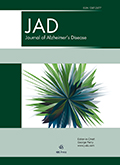Authors: de la Monte, S.M. | Ganju, N. | Feroz, N. | Luong, T. | Banerjee, K. | Cannon, J. | Wands, J.R.
Article Type:
Research Article
Abstract:
Cell loss and neuritic/cytoskeletal lesions represent two of the major categories of dementia-associated structural abnormalities in Alzheimer's disease (AD). Cell loss is ultimately mediated by apoptosis and mitochondrial DNA damage due to enhanced sensitivity to oxidative stress, but the mechanism responsible for the neuritic/cytoskeletal lesions including the abnormal proliferation of cortical neurites is not known. This study examines the potential role of oxygen free radical injury as a factor contributing to both cell death and neuritic sprouting cascades in AD. PNET2 human neuronal cells were treated with H2 O2 (8 μM to 88 μM) for 24 hours and then
…analyzed for viability, DNA damage, and pro-apoptosis, survival, and sprouting gene expression and signaling. H2 O2 -treatment resulted in dose-dependent increases in cell death due to genomic and mitochondrial DNA damage associated with increased levels of 8-OHdG and the p53 and CD95 pro-apoptosis genes, reduced levels of the Bcl-2 survival gene, activation of JNK and p38 stress kinases, and inhibition of PI3 kinase survival signaling. However, the H2 O2 -treated cells also manifested increased expression of growth and sprouting molecules, including GAP-43, nitric oxide synthase 3, neuronal thread protein (NTP; ~ 17 kD and ~ 21 kD forms), proliferating cell nuclear antigen, and phospho-Erk MAPK, and normal levels of the AD-associated ~ 41 kD NTP species, cyclin dependent kinase 5 (cdk-5), and phospho-tau. In addition, the H2 O2 -treated cells had increased levels of p25, the catalytically active and stable cleavage product of p35, which regulates cdk-5 activity. Previous studies demonstrated p25 accumulation in AD brains and p25-induced hyperphosphorylation of tau and neuronal apoptosis. The findings herein suggest that oxygen free radical injury in human CNS neuronal cells is sufficient to cause some but not all of the pro-death and pro-sprouting molecular abnormalities that occur in AD.
Show more
Keywords: free radical, apoptosis, mitochondria, neuritic sprouting, neurodegeneration
DOI: 10.3233/JAD-2000-23-406
Citation: Journal of Alzheimer's Disease,
vol. 2, no. 3-4, pp. 261-281, 2000
Price: EUR 27.50





